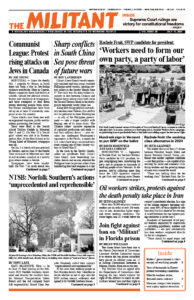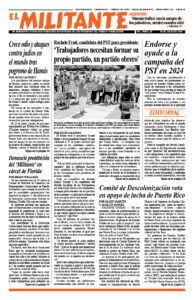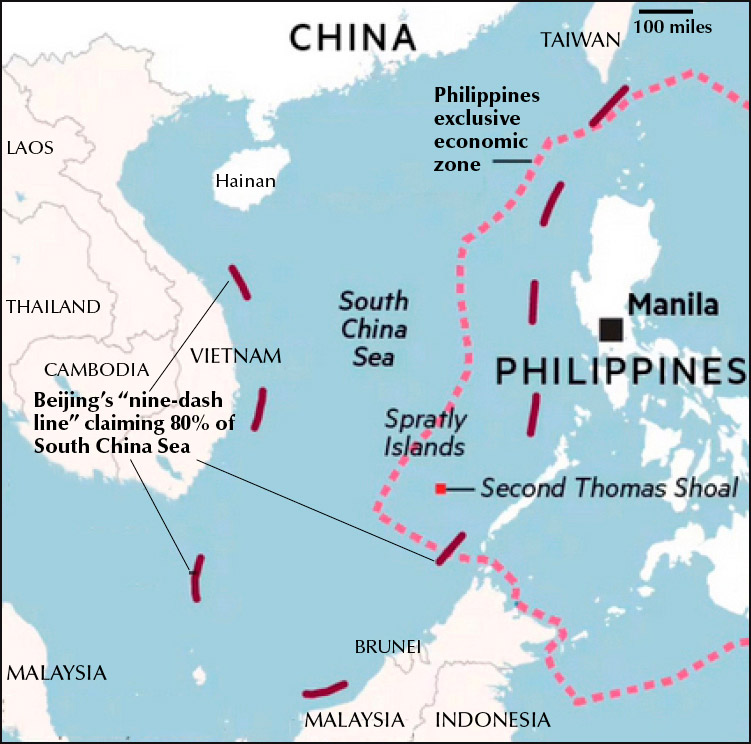China’s Coast Guard vessels repeatedly rammed and then troops boarded Philippine naval vessels, injuring several sailors in the Spratly Islands June 17. The clash was the most violent encounter to date between Chinese and Filipino forces whose rulers both claim the Second Thomas Shoal in the strategically important South China Sea.
Along with rising political and military tensions over Taiwan, this conflict has the potential to draw Washington — an ally of the Philippine government — into a larger conflict with Beijing, one of its main rivals. The Chinese rulers’ massive expansion of capitalist production and trade — and their military forces — over decades has challenged Washington’s supremacy in the Pacific, a region the U.S. rulers have long considered their prize coming out of their bloody victory in World War II.
In the clash in the Spratly Islands, sailors on speedboats from China’s Coast Guard, some brandishing machetes, knives and an axe, attacked the Philippine boats to prevent sailors from transferring food and weapons to a tiny garrison there. Some of their equipment was seized by Beijing’s forces.
The Philippine government said the Chinese sailors behaved “like pirates.” Beijing said the Filipinos were “trespassing.” The yearslong territorial flashpoint centers on a rusting World War II ship, beached in 1999 as a Philippine outpost on the shoal. It is 120 miles from the westernmost island in the Philippines and more than 600 miles from China’s southernmost point.
The conflict underscores the instability racking capitalist powers across the region and the threat to the working class of more wars.
The White House condemned Beijing’s “escalatory and irresponsible actions.” The U.S. rulers’ imperialist allies from Europe to Japan and Australia did likewise.
Just over two weeks earlier, Philippine President Ferdinand Marcos Jr. had warned Beijing that causing any fatalities among Filipinos in these clashes would be akin to “an act of war.”
After the attack, Manila tried to deescalate tensions, under pressure from Washington, which is pursuing its own imperial interests. Marcos told Filipino troops June 23 that his government “is not in the business to instigate wars” and would refuse “to choose sides in a great power competition.”
During Marcos’ visit to the U.S. in April, President Joseph Biden said Washington’s commitment to its 1951 mutual defense pact with the Philippines was “ironclad.” The White House promises it will support its ally in the event of any armed attack.
In 2012, Beijing wrested control of Scarborough Shoal, which lies within an exclusive economic zone claimed by the Philippine government.
The Obama administration abandoned the U.S. rulers’ “ally” in the confrontation. The previous president of the Philippines, Rodrigo Duterte, responded by drawing closer to Beijing and Moscow. But as the Philippine rulers’ territorial conflict with Beijing sharpened, Duterte backtracked.
Stakes in South China Sea conflicts
Today Washington is trying to cement a network of alliances in Asia and the Pacific aimed at countering Beijing, centered on its imperialist allies in Japan and Australia. It stations tens of thousands of troops across the region.
The Philippine government has allowed U.S. forces access to nine of its military bases. Washington and the Indian government have supplied missile defenses to the Philippines, while the rulers in Japan have provided patrol boats.
Washington is staging a series of joint maritime exercises with Manila’s military, along with forces from France, Japan and Australia, in disputed waters west of the Philippines. At the same time, Beijing dispatched an aircraft carrier to join its other warships in the South China Sea, near the Philippine coast.
As their economic clout has grown over decades, China’s rulers have aggressively asserted claims to an arc of islets in the western Pacific. Beijing claims sovereignty over 80% of the South China Sea. But this is contested by overlapping counterclaims from the governments of Brunei, Indonesia, Malaysia, the Philippines, Taiwan and Vietnam.
A United Nations tribunal denied the Chinese government’s territorial claims in 2016. Ignoring this, Beijing has been reinforcing underwater reefs as artificial islands with airfields and military bases, backed up by its Coast Guard ships, maritime militia boats and fishing fleets.
A new law adopted by Beijing June 15 authorizes its coast guard to seize foreign ships “that illegally enter China’s territorial waters” and detain foreign crews for up to 60 days. It empowers China’s Coast Guard to open fire.
Today around a third of global shipping goes through the South China Sea with $3 trillion of trade passing to and from busy ports in China, Japan, South Korea and elsewhere in East Asia. It also has large oil and gas reserves and 12% of the world’s fish catch.
Clashes in the South China Sea pose new challenges to Washington, the world’s final empire, as it seeks to shore up its place in an increasingly unstable world. The threat of more wars can only by brought to an end by the working class, as it becomes strong enough to take power out of the hands of the capitalist war makers.


